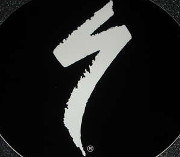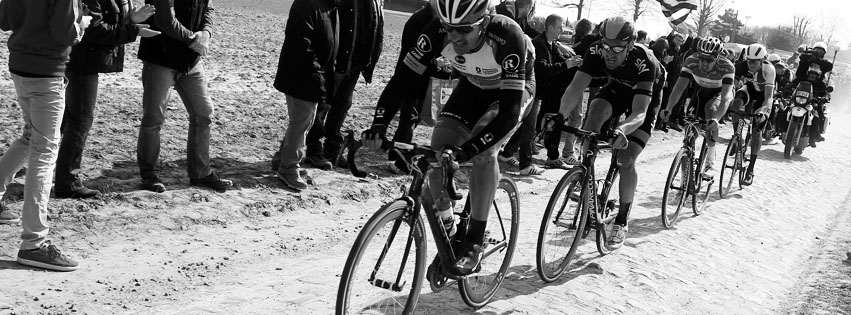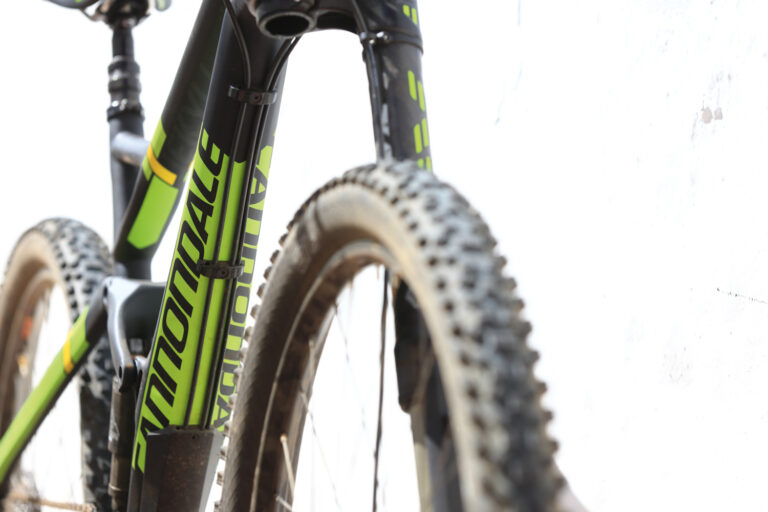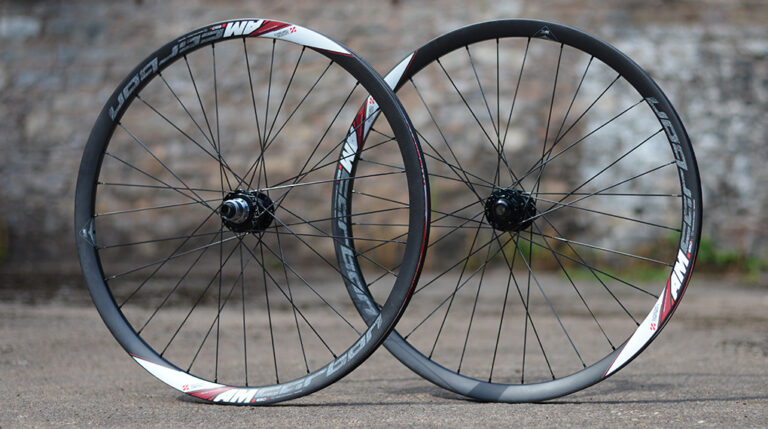SANTA CRUZ V10 C – Lightest with fullest carbon content

World Cup downhill’s most successful bike was running in 8” mode out here in Italy, although it can be topped–up to 10” with the flick of a switch. Being the only complete carbon bike it has to be light and sure enough the scales settled the score on that very quickly – 34.02lb without pedals and one point to Santa Cruz.
With excellent, and more importantly, hardwearing frame protection, a shock that’s nicely guarded from crap, it’s a chassis with over a decade of development and it shows. It’s a refined bike. And whilst there is no internal cable routing we found swapping the front triangle and working on the bike extremely simple. A ‘works’ bike for sure. Size wise we had a large but also had the XL front triangle, which was a better fit for 6’ plus riders.
ComponentsThis is without question one gem of a bike laced with quality parts from Easton, Thomson, Enve – and so it should for the £8448 price tag! However we all felt a little disappointed to a degree – the missing Shimano Saint or carbon crank replaced by a cheaper feeling Truvativ Descendant, the rough finish chain retention and ring. Clutch type derailleur was a welcome component given the conditions. Oversized bars feel overkill and the mechanically brilliant Saint brakes feel too fierce, at speed you’re not able to dab without any drag. Too urgent in reaction, the Saint needs to deliver a more delicate lever input – it’s a bicycle not a carthorse.
Exclusivity/DetailChris King hubs (rather than the DT’s supplied) would give the V10 more of a team replica feeling, but the full carbon build, including rims, certainly puts the Santa Cruz in a different place compared to the others on test. If this was a test on carbon content, here’s your winner. But the V10 is about the package, the colour balance and imagery. It looks so well balanced visually. As an exclusive package it’s very good too, but many thought it was second best to the Specialized Demo – many would like to see a team replica build. However, being the lightest with biggest carbon content is where it wins its exclusivity.
Suspension/settings Having spent a fair amount of time on this V10 and the older model this bike had a head start in terms of settings. That it had been ridden with full Fox Racing support to get set–up with both the coil and air forks was immediately clear on arrival in Italy, as many riders commented that this was the best V10 they’d ever ridden. Having experimented with harder and softer suspension pressures front and rear (within the individual rider weight sag window) I feel that the harder rear puts slightly too much force onto the front of the bike and the higher bottom bracket height affects corner poise too much.
Having spent a fair amount of time on this V10 and the older model this bike had a head start in terms of settings. That it had been ridden with full Fox Racing support to get set–up with both the coil and air forks was immediately clear on arrival in Italy, as many riders commented that this was the best V10 they’d ever ridden. Having experimented with harder and softer suspension pressures front and rear (within the individual rider weight sag window) I feel that the harder rear puts slightly too much force onto the front of the bike and the higher bottom bracket height affects corner poise too much.
Opting for the new Air 40 up front, together with the new rear damper, gave us more flexibility for different riders, plus they are slightly better. For the price tag many will expect the V10 to come with an Air 40 as standard. On track the Fox units as a package had superb parity, our only niggle being that I’d like to have worked more on the progressivity than simply air and compression settings. On the dials we went pretty average and roughly four clicks on the harder side of middling. Overall it was a tight call between the Trek and Santa Cruz for best suspension units in the harder charging territory out in Italy.
RideOverall the V10 becomes more of a muscle bike than previous versions with the Fox units, but doesn’t lose its difficulty in setting up. The Trek was far easier in this respect and was simpler to ride even when you did get it wrong. The V10 gets upset by slight changes to damping which we saw when other riders began from scratch.
As mentioned, many of the test riders commented that this was the best V10 they had ridden, others simply hated it because of the difficulty in setting it up, it’s definitely one that requires time on the dials and definitely needs to be ridden hard to get the best out of it. Instantly I felt balanced out here and could charge into terrain at will. Riding the lighter 450 spring has an effect on fork performance with less emphasis up front, the bike positioned in a better place more of the time for downhill action. The bike now ripped into and out of corners confidently rather than slightly precariously. In 8” mode the V10 seems to have better poise to it and less weight transfer to compensate.
The secret is very much in managing the balance on each wheel – yes the V10 feels less lively once the damping has been stiffened up to keep the poise, however, lightening off the rebound the bike became slightly more difficult to control and quickly moved away from the really balanced ride characteristic we’d achieved.
Overall The V10 was the hardest bike to weigh up overall. For me it simply wasn’t as compelling as the other three. In its minutest detail, although I enjoyed the V10 most of the time there were moments when it wasn’t clear where your weight was going. This was particularly the case in tough sections where the Trek Session and Specialized Demo were straightforward to understand and weight, whereas the V10 had you momentarily second–guessing.
The V10 was the hardest bike to weigh up overall. For me it simply wasn’t as compelling as the other three. In its minutest detail, although I enjoyed the V10 most of the time there were moments when it wasn’t clear where your weight was going. This was particularly the case in tough sections where the Trek Session and Specialized Demo were straightforward to understand and weight, whereas the V10 had you momentarily second–guessing.
We constantly had a twang from the back wheel on square edge hits entering tough sections. It didn’t slow you down, it was just obvious. The bike rides quietly. I’m left wondering if it is slightly too stiff and think the sizing is small for a large. On the XL you could open your legs out and on longer tracks it was a definite advantage.
The overwhelming feeling for me however is how much more positive I feel about the V10 in terms of set–up. It’s a great bike although not able to charge into danger with as much composure as the Demo and not as lively as the Session generally. The more sensitive ride to the Trek appealed to more riders. Maybe the V10 is one for beating hard.
SANTA CRUZ V10 CARBON SPEC| Frame | V10 Carbon |
| Shock | Fox DHX RC4 |
| Forks | Fox 40 RC2 |
| Headset | Cane Creek 40 |
| Stem | Easton Havoc 35 Direct mount, 50mm |
| Bars | Easton Havoc 35 |
| Grips | Lizard Skin Peaty Lock–on |
| Brakes | Shimano Saint, Ice Tech rotors |
| Levers | Shimano Saint |
| Rear Derailleur | Shimano Saint, 10 speed |
| Shifter | Shimano Saint, 10 speed |
| Cassette | Shimano 5700, 11–28, 10 speed |
| Chain | Shimano HG 74, 10 speed |
| Crankset | SRAM Descendent, 165mm, 38T |
| Chainguide | E13 LG1 |
| Rims | ENVE Composites DH |
| Front Hub | DT Swiss 240, 20mm |
| Rear Hubs | DT Swiss 240 |
| Saddle | WTB Silverado SLT |
| Seat Post | Thomson Elite |
| Weight | 34.02lb |
Price £8448
TREK SESSION – Of all the bikes this was the one that generated the most smiles
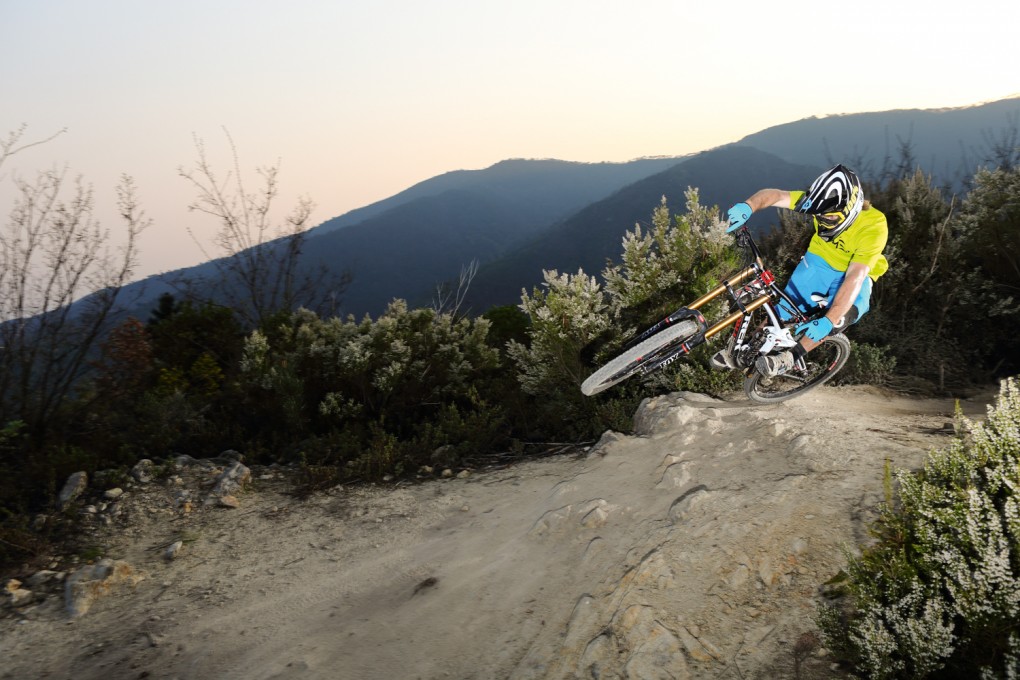
Shipped in the ‘High’ setting the Session was immediately re–set into its ‘Low’ position. Why would you need higher/steeper on a downhill bike? Immediately the Trek feels cramped for a size large, something that became increasingly obvious on the tough San Romolo terrain. Large might work for some riders around 5’9” – 6’ as a park/play bike, but the reality is that for downhill action riders over 5’ 10” should be looking to the XL version. The carbon ‘feel’ on this bike is less harsh than some and comes with a real character to it. It’s not crude, has no rattles or squeaks and the frame protection is ‘A star’.
ComponentsAlmost perfect, and like the Demo the Session really benefits from a super fast DT wheelset package which could play a part in the outcome of the final top two bikes. The rims do give way under bigger collisions but generally they dealt with a week in rock. Saint brakes, again not so good in flat–out scenarios due to their cold severity, but the Saint crank comes where security is needed. Bars are simply too narrow, the stem not adjustable (as featured on Demo or V10). The clutch derailleur meanwhile is an obvious choice (but missing on two of the bikes), chain retention the finest in the business.
 Exclusivity/Detail
Exclusivity/Detail
What price a smile? Cheesy but true, the Trek was an instant hit within one run from nearly every rider. The finish, colour balance, paintwork and frame detailing including cable routing on this bike is simply sublime. Is it exclusive? I feel the carbon integrity of this bike gives it exclusivity in its ride sensitivities, which are matched with a ‘worked on’ damping system. As a suspension ‘system’ here is the overall winner. That’s pretty exclusive. What price do you put on that? A huge amount as we were to find during the week. Lesser in menace than the original black and red model, many of the test riders felt the white paintwork looked weak against the other bikes. But enough of cosmetics…it exclusivity is won in the way the bike interacts with the terrain, the carbon structure.
Suspension/settingsEarly rides highlighted the need for riders to ‘settle’ on the tough Italian tracks. The Trek felt nervous. But crucially that edginess became its strength later in the week. A bike that was definitely not upset as much to changes in settings as the V10, the recommended air assist settings felt too hard for a few riders on the super technical tracks and even on the harder faster terrain felt slightly too much. 30psi up front worked well for a 90kg rider on a hard charging track. Out the back we worked on 150psi in boost valve with little bottom–out but upped this to 210psi with bottom out one turn from closed. There was a need to work on rear spring rate and erred on the side of weak simply to keep the bottom bracket at its lowest.
 It was patently clear by day two that Trek had the best suspension/damper package on test. It also felt more comfortable in ‘out of sync’ settings and the rear felt more lively and tuned into the terrain than the other bikes, more than that, the response time to impacts was more instantaneous than the others. The Session needed some work to avoid mid stroke choking at times, something we did with increased boost valve pressure and progressivity, and overall we opted for harder compression settings and even these suited the lighter riders.
It was patently clear by day two that Trek had the best suspension/damper package on test. It also felt more comfortable in ‘out of sync’ settings and the rear felt more lively and tuned into the terrain than the other bikes, more than that, the response time to impacts was more instantaneous than the others. The Session needed some work to avoid mid stroke choking at times, something we did with increased boost valve pressure and progressivity, and overall we opted for harder compression settings and even these suited the lighter riders.
Up front the Hybrid air doesn’t feel a million miles different from the new Air 40 (except the air 40 doesn’t have the hideous spring knock) but on the rear Trek have demonstrably upped the performance and workings between shock and suspension design since the bike was launched five years ago. This could be the most beautifully balanced suspension system in the game right now.
RideIt took a few runs, yet from feeling slightly perched at first relative to the Demo and V10, and with too much fork deflection because of those over eager pressure recommendations…and not enough rear support, the fix was a quick one.
The Session feels the steepest (head angle) bike however and if it came with a Cane Creek AngleSet we would use it. Because of the very slightly prone position, due to its marginally high BB height, the ride is frequently with bent rather than ‘open’ knees, this does mean however that a slight extension of the leg delivers drive in certain shaped terrain. This is something you cannot do on the Demo so easily with the lower bottom bracket. The Trek is super fast on power take–up.
OverallThis bike is too small for 6’ riders, the large Session is cramped and your legs get tired about a minute into your run and the problem remained of control when exiting major G–outs or speed bumps because of the small sizing. Ultimately this does highlight its superb suspension ‘system’ – the best on test – and its overall balance. For even with a big old bird weight transferring forward and rear, the Session doesn’t do a bad job of keeping its posture. Yet as fully brilliant as the Session is, we are left wanting that extra large – the fact that frustratingly we can’t bloody get one adds to its enigma. Every rider that got on board the Session at one point believed it to be the outright winner. It was the easiest to set up for all the riders and everyone loved it.
Evolved, fine–tuned, call it what you will, it’s brilliant work by Trek on ride dynamics. It can dance you out of danger in an instant and of all the bikes the Trek is certainly the most fun bike to ride, and for many riders that is enough
TREK SESSION 9.9 SPEC| Frame | Trek Session Carbon 9.9 |
| Shock | Fox DHX RC-4 |
| Forks | Fox Factory Series 40 fit RC2 Hybrid Air |
| Headset | Cane Creek 40, E2 |
| Stem | Truvativ Holzfeller Direct Mount |
| Bars | Bontrager Rhythm Pro Carbon |
| Grips | Bontrager Lock–on |
| Brakes | Shimano Saint |
| Levers | Shimano Saint |
| Rear | Derailleur Shimano Saint Shadow Plus |
| Shifter | Shimano Saint, 10 speed |
| Cassette | Shimano Ultegra 11-25, 10 speed |
| Chain | Shimano |
| Crankset | Shimano Saint 36T |
| Chainguide | MRP G3 Carbon |
| Rims | DT Swiss FR 600 32h |
| Front Hub | DT Swiss 240S, 20mm |
| Rear Hub | DT Swiss 240s, 157×12 |
| Saddle | Bontrager Evoke 3 |
| Seat Post | Bontrager Rhythm Elite |
| Weight | 36.14lb |
Price £7000



